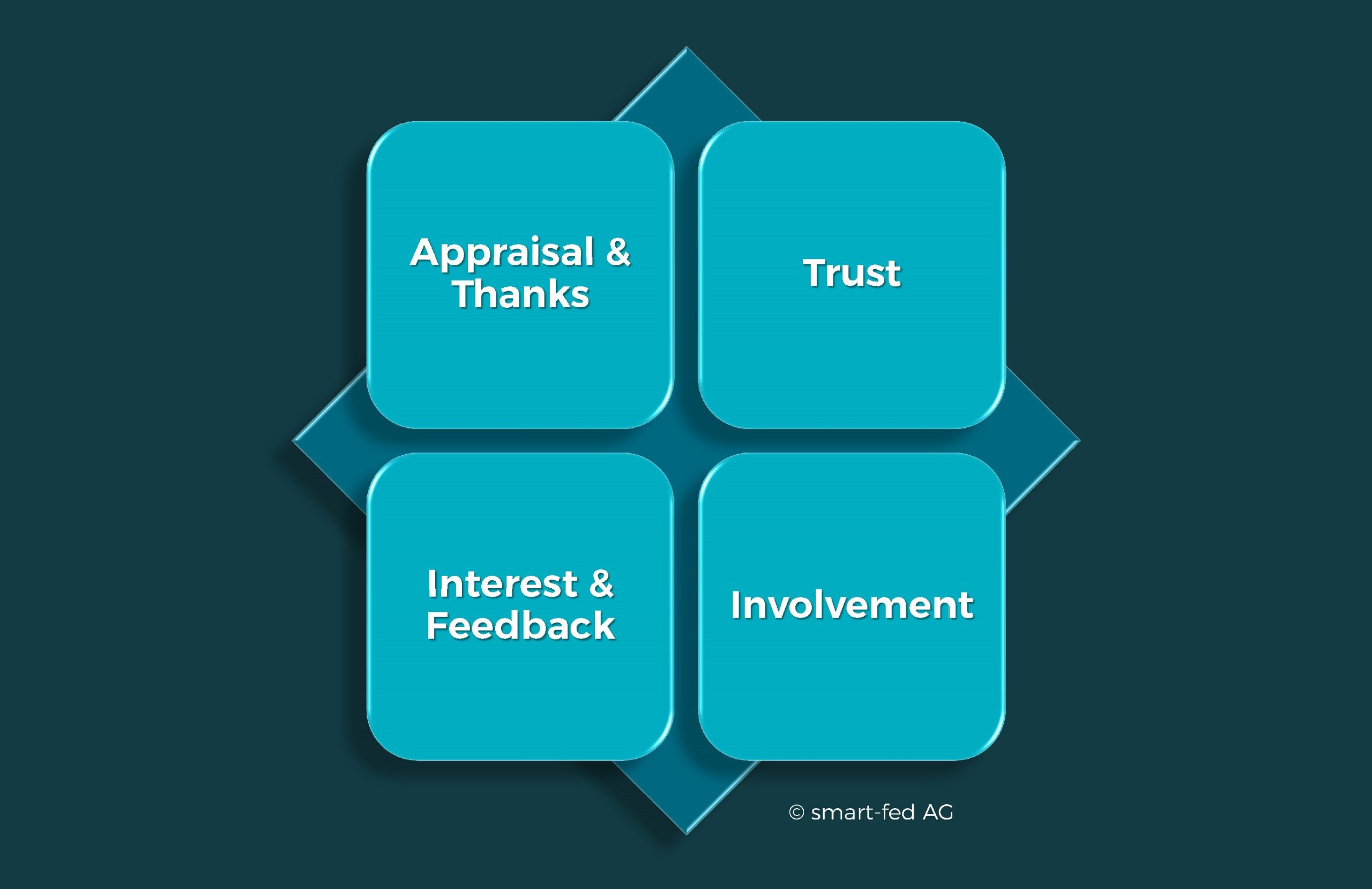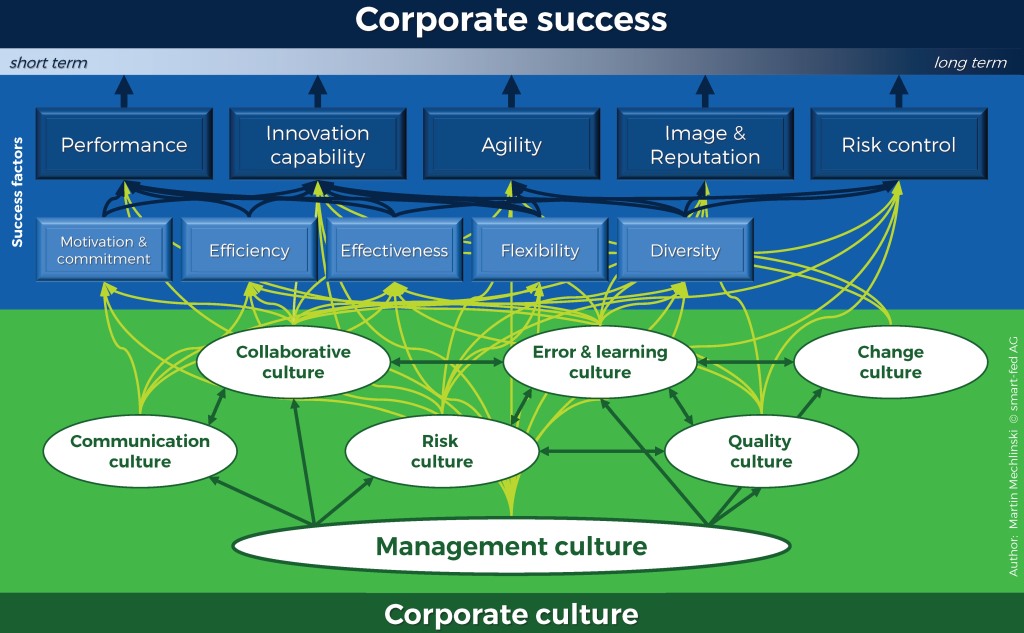The four dimensions of appreciation
Appreciation has an enormous influence on the motivation and commitment of employees. This fact is certainly not new, and yet this quality factor is often neglected in employee management. One reason for this is probably that it takes up our scarce resource “time” – … which is only partly true.
Appreciation can be expressed in many different ways. This article aims to provide suggestions and raise awareness of this important topic. The starting point for this is the four dimensions of appreciation
Appraisal & Thanks
This dimension is probably the first thing that comes to mind when we talk about appreciation. After all, recognition of performance and commitment is one of the central human needs. Which is ultimately also the basis for the like hype in social networks.
But in the everyday life of our organizations, it’s about more than a superficial like. This is where genuine appreciation is needed. For example, personal praise from superiors for exceptional performance or a small thank-you for above-average commitment and flexibility.
This does not cost much more in everyday life than a little attention and an awareness that not everything and anything in the company has to be taken for granted.
The next step up from personal praise is official acknowledgement of performance and commitment on internal web platforms, at team, departmental and project meetings, or on special events such as employee information sessions.
Trust
Active trust in employees is another very strong form of appreciation.
In this case, active does not just mean talking about it, but actually giving employees more demanding tasks, more responsibility for results, and expanded action and decision-making authority, and thus more freedom and personal responsibility.
Trust is also reflected in an open resp. transparent communication and information policy. Withholding information is not only seen as mistrust, but also as a form of personal disrespect. Managers at all levels should be aware of this.
Involvement
Here, appreciation is based on dialog with employees at eye level and recognition of their professional competencies.
By involving employees in important operational decisions or strategic development processes, their knowledge, experience and qualifications are valued. This not only promotes self-esteem but also the comprehensibility and acceptance of decisions.

The key point here is that inclusion is not limited to upper and middle management. Lower management and employees are also explicitly included here.
Interest & Feedback
Admittedly a dimension that takes time.
In concrete terms, this means that you must regularly deal with the performance and results as well as the successes and failures of your employees. Not only in the context of the appraisal interview!
This always includes timely and constructive feedback. In other words, it should be concrete, goal-oriented and motivating. In this way, positive as well as critical feedback is perceived as appreciation.
Salary & Bonus?
Well, according to Frederick Herzberg, low resp. underfunded wages mainly contribute to employee dissatisfaction. For them, it is a disrespect for their work and themselves, and sooner or later leads to increased employee turnover.
High or above-average salaries as well as bonuses, on the other hand, are seen as a legitimate entitlement for special performance requirements, difficult working conditions or risk bonuses, or for having achieved or exceeded predefined targets. For these people, they are taken for granted and are hardly perceived as appreciation
Exceptions in this context are extra bonuses or gifts, e.g. as special thanks for personal commitment, achievements, successes or anniversaries. These again fall into the dimension of appreciation & thanks.
⇒ Author: Martin Mechlinski / SMART FED
The four dimensions of appreciation
Appreciation has an enormous influence on the motivation and commitment of employees. This fact is certainly not new, and yet this quality factor is often neglected in employee management. One reason for this is probably that it takes up our scarce resource “time” – … which is only partly true.
Appreciation can be expressed in many different ways. This article aims to provide suggestions and raise awareness of this important topic. The starting point for this is the four dimensions of appreciation
Appraisal & Thanks
This dimension is probably the first thing that comes to mind when we talk about appreciation. After all, recognition of performance and commitment is one of the central human needs. Which is ultimately also the basis for the like hype in social networks.
But in the everyday life of our organizations, it’s about more than a superficial like. This is where genuine appreciation is needed. For example, personal praise from superiors for exceptional performance or a small thank-you for above-average commitment and flexibility.
This does not cost much more in everyday life than a little attention and an awareness that not everything and anything in the company has to be taken for granted.
The next step up from personal praise is official acknowledgement of performance and commitment on internal web platforms, at team, departmental and project meetings, or on special events such as employee information sessions.
Trust
Active trust in employees is another very strong form of appreciation.
In this case, active does not just mean talking about it, but actually giving employees more demanding tasks, more responsibility for results, and expanded action and decision-making authority, and thus more freedom and personal responsibility.
Trust is also reflected in an open resp. transparent communication and information policy. Withholding information is not only seen as mistrust, but also as a form of personal disrespect. Managers at all levels should be aware of this.
Involvement
Here, appreciation is based on dialog with employees at eye level and recognition of their professional competencies.
By involving employees in important operational decisions or strategic development processes, their knowledge, experience and qualifications are valued. This not only promotes self-esteem but also the comprehensibility and acceptance of decisions.
The key point here is that inclusion is not limited to upper and middle management. Lower management and employees are also explicitly included here.
Interest & Feedback
Admittedly a dimension that takes time.
In concrete terms, this means that you must regularly deal with the performance and results as well as the successes and failures of your employees. Not only in the context of the appraisal interview!
This always includes timely and constructive feedback. In other words, it should be concrete, goal-oriented and motivating. In this way, positive as well as critical feedback is perceived as appreciation.
Salary & Bonus?
Well, according to Frederick Herzberg, low resp. underfunded wages mainly contribute to employee dissatisfaction. For them, it is a disrespect for their work and themselves, and sooner or later leads to increased employee turnover.
High or above-average salaries as well as bonuses, on the other hand, are seen as a legitimate entitlement for special performance requirements, difficult working conditions or risk bonuses, or for having achieved or exceeded predefined targets. For these people, they are taken for granted and are hardly perceived as appreciation
Exceptions in this context are extra bonuses or gifts, e.g. as special thanks for personal commitment, achievements, successes or anniversaries. These again fall into the dimension of appreciation & thanks.
⇒ Author: Martin Mechlinski / SMART FED









